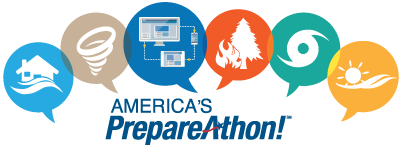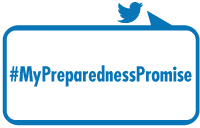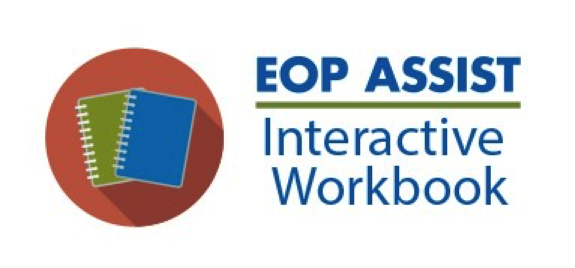|
News & Updates From the REMS TA Center, Spring 2016
|
Testing, Testing 1, 2, 3:
Assess Your Knowledge of Key Concepts in Emergency Management
|
 The
six-step planning process is cyclical, which means that it’s always a good time
to brush up on your knowledge of advanced topics in school and higher education
emergency management. Let us help you! Use your knowledge and expertise in
emergency management to answer questions you will find throughout this
newsletter. Clues are provided if you need help. And you can hone your
understanding of these principles anytime using EOP ASSESS, a tool that helps practitioners from schools
and institutions of higher education to assess their knowledge of elements
critical to the process of creating and maintaining a high-quality emergency
operations plan. You will even walk away with a free report at the end to help
your learning continue! The
six-step planning process is cyclical, which means that it’s always a good time
to brush up on your knowledge of advanced topics in school and higher education
emergency management. Let us help you! Use your knowledge and expertise in
emergency management to answer questions you will find throughout this
newsletter. Clues are provided if you need help. And you can hone your
understanding of these principles anytime using EOP ASSESS, a tool that helps practitioners from schools
and institutions of higher education to assess their knowledge of elements
critical to the process of creating and maintaining a high-quality emergency
operations plan. You will even walk away with a free report at the end to help
your learning continue!
Responding to Climatic Changes That Come With
Spring—Safety and Preparedness Planning for Institutions of Higher
Education
According to the National Weather Service’s (NWS)
Climate Prediction Center,
the start of spring brought with it a variety of natural hazards, including
extreme heat in the southwest, heavy rains and severe weather in the southeast,
and high winds plus below normal temperatures in the northeast.

To be prepared for
a variety of severe weather hazards and unpredictable climate conditions, institutions
of higher education (IHEs) should follow the six-step planning process detailed
in the Federal Guide for Developing
High-Quality Emergency Operations Plans for Institutions of Higher
Education (IHE Guide) and develop severe weather annexes. If they haven’t done so already, higher education
administrators and officials should meet with their core emergency operations
plan (EOP) development planning team to assess the risks posed from the weather
system that poses a threat. Region-specific information from NWS on the hazards
outlook for the United States can be found here: http://www.cpc.ncep.noaa.gov/products/predictions/threats/threats.php
If a
weather-related disaster is likely, IHEs should identify specific courses of
action. These begin with first creating goals for each hazard and at least one objective
for each goal, such as the following:
- Possible Severe Weather Goal: Help ensure students and staff
have a safe route to/from buildings on campus.
- Possible Severe Weather Objective: Help ensure communication
strategies are in place to notify students and staff of re-routed traffic in
the case of flooded roads.
IHE core EOP
development planning teams should also review and update hazard-specific
annexes for severe weather events, such as extremely hot/cold weather and
floods, if needed. Once courses of action have been updated and/or reviewed, the
team should help ensure all stakeholders are aware of their roles and how to
respond in an emergency.
For more helpful
information on the development of threat- and hazard-specific annexes, visit
the At a Glance version of the IHE Guide on the REMS TA Center Website at: http://rems.ed.gov/IHEThreatAndHazardAnnex.aspx.
|
|
Testing, Testing 1, 2, 3: Question #1
|
|
Name the mission areas that are included in
Presidential Policy Directive (PPD)-8: National Preparedness by filling in the
blanks.

(Clue: Visit our home page to find
the answer prominently displayed.)
Swatting Incidents Highlight the Importance of Collaboration on Local,
State, and Federal Levels
Swatting occurs
when a hoax or false report of danger is made to emergency service providers.
The anonymous 9-1-1 call or email is made with the intention of soliciting a law
enforcement response, usually by a SWAT (Special Weapons and Tactics) team. These
threats can come in various forms, such as pre-recorded phone calls, emails,
and messages posted on social media that mask the origin of the threat. Local
and national news reports have taught us that many states, school districts, schools,
and institutions of higher education (IHEs) have had to respond to swatting during
this academic year in the form of bomb threats, reports of active shooters, and
incidents of other serious human-caused threats.
Not only can swatting
disrupt the learning environment, it can also result in wasted school, IHE, community,
and/or state resources. Furthermore, it temporarily disables these resources
for the community if a real threat were to occur at the same time. Swatting
hurts the victims and the responders creating traumatic experiences for those
involved in the heightened response. Although it is not a new phenomenon,
swatting has caused new concerns, as encryption can make it difficult to track
the source of the threat, and as threats made and publicized on social media
can sometimes heighten the level of fear associated with an attack, thereby
disrupting the response process. For example, sometimes reports on social media
prompt parents to rush to a school to check on the safety of their children, which
in turn can make it more difficult for first responders and administrators to
do their job of ensuring safety and getting students back to school.
If nothing else,
swatting reinforces the importance of collaboration on the Federal, state, and local
levels. Schools and IHEs should work closely with their local law enforcement
and others, such as parents/guardians, to identify not only how to respond to
such incidents but also how to help prevent them from occurring in the first
place. For example, superintendents, IHE administrators, state education departments,
political leaders, and community partners across the country have been looking
for solutions to the problem in town hall meetings and through working with the FBI to investigate sources of
swatting. Also, Congresswoman Katherine Clark (D-MA) and Congressman Patrick
Meehan (R-PA) introduced the Interstate Swatting Hoax Act of
2015, a
bipartisan bill that aims to address dangerous examples of swatting. Collaboration
can also include families. Together, schools and their partners can talk with
students and teach them that swatting is not a prank—not only is it
dangerous, but it is also a crime
Whether or not a
threat is unfounded, districts, schools and IHEs must remain prepared to
respond to all types of threats and hazards that may impact a school, campus,
or surrounding community, including adversarial and human-caused threats like
swatting. And leaders at those districts, schools, and IHEs must be prepared to
work in a collaborative fashion with all those individuals and entities that
can support them through the process of prevention, protection, mitigation,
response, and recovery.
|
|
Testing, Testing 1, 2, 3: Question #2
|
|
In what section
of an EOP should schools or IHEs include plans for continuity of learning and
operations? (Clue: Find the answer within the guides for developing high-quality school and higher
ed EOPs on our site.)
New Campaigns, Resource Releases, and Product
Updates From the REMS TA Center
Celebrate America’s PrepareAthon! With the U.S. Department of Education and
the REMS TA Center
During the months of April and May, the REMS TA Center will be
conducting weekly activities in support of the Federal Emergency Management
Agency’s America’s PrepareAthon! (AP!) national campaign and National
PrepareAthon! Day on April 30. Our goal is to highlight the work that you are
doing on the state and local level to create, revise, and practice emergency
operations plans (EOPs) and to help ensure that your state and local education
agencies are prepared to respond to all hazards. Through these activities, we hope
to hear and share success stories, lessons learned, and resources from our
state, local, and Federal partners in school and higher education emergency
management. Stay tuned for invitations to participate and/or present and share
during the following AP! activities we will be hosting this month.

6 Twitter Web Chats
on #SevereWx and Other Key Topics in Emergency Management
- Week 1: Flood | Thursday, April 14, 2 PM
- Week 2: Tornado | Thursday, April 21, 2 PM
- Week 3: Our NEW Emergency Management Virtual
Toolkit | Thursday, April 28, 2 PM
- Week 4: Wildfire | Thursday, May 5, 2 PM
- Week 5: Hurricane | Thursday, May 12, 2 PM
- Week 6: Extreme Heat | Thursday, May 19, 2 PM
Follow us on Twitter @remstacenter to join the Twitter
chats. We want to hear from you!
A Special
#PrepareAthonForSchools Community of Practice Forum
The U.S. Department of Education, the REMS TA Center,
and other Federal partners in emergency management want to know how you plan to
practice your response plan for all hazards during AP! and year round. In the
next newsletter, we will feature #PrepareAthonForSchools highlights from across
the country. We hope your resource, story, or lesson learned is one of the ones
shared!
To start sharing, use the following link to visit the CoP.
This link will direct you to the forum. Once you’re in, click New Topic and begin
typing. http://rems.ed.gov/COP/REMSCOPforum/topics.aspx?ForumID=97
|
|
Testing, Testing 1, 2, 3: Question #3
|
|
What
is the name of the national system that schools and IHEs can use to manage
incidents in collaboration with community partners, such as emergency medical
services personnel, law enforcement, and state emergency operation centers? (Clue: This information is very important and appears in multiple places on our
Website, for both schools and IHEs.)
Share Your #MyPreparednessPromise With the Field
 There are many actions that schools, IHEs, community
partners, and individuals must take to help ensure that schools and campuses
are safe and healthy learning environments. We understand if that
responsibility may seem daunting, and we also understand the need to take time periodically
to focus actions on one thing at a time. There are many actions that schools, IHEs, community
partners, and individuals must take to help ensure that schools and campuses
are safe and healthy learning environments. We understand if that
responsibility may seem daunting, and we also understand the need to take time periodically
to focus actions on one thing at a time.
The REMS TA center is kicking off 2016 with a new #MyPreparednessPromise
national campaign to encourage you to share one thing you promise to do this
year to promote and/or engage in emergency preparedness activities for schools
or IHEs.
Interested in Participating? Learn How Below.
- Download any one of the #MyPreparednessPromise
banners available on our Creative Materials page.
- Print a copy of the banner and write your
promise in the blank space.
- Share a picture of your completed banner or share
a selfie holding the banner with the REMS TA Center via:
a. Social Media: Tag @remstacenter and add
the #MyPreparednessPromise hashtag
when you add your post.
b. Email: Send a copy of your promise to info@remstacenter.org under the subject
line #MyPreparednessPromise.
You can also share your promise by visiting the TA Center
exhibit booth at select emergency management conferences across the nation. To
learn where we will be and when, see the last article in this newsletter.
Learning in Progress—Thanks for Your Patience While We Update Two
Trainings by Request
The REMS TA Center has suspended delivery of our Adult Sexual Misconduct in Schools:
Prevention and Management (ASM) and Threat
Assessment in Schools: Basics and Benchmarks (SSI) Trainings by Request (TBRs)
while we revise the content to integrate new research, Federal recommendations,
and lessons learned in the field. In the meantime, we are still able to provide
support and information on these topics; please email us at info@remstacenter.org with any questions
related to these important subjects. You can also drop us a note to receive a
notification when the revised training is available.
Please note that we are still offering several important TBR
topics, including our Developing
Emergency Operations Plans (EOPs) K-12 101, Developing Emergency Operations
Plans (EOPs) IHE 101, and/or our Resilience
Strategies for Educators: Techniques for Self-Care and Peer Support (RSE) TBRs. We offer all three trainings in Train-the-Educator and Train-the-Trainer
formats. If you would like to learn more about these offerings, or apply to
host a training yourself, find more information at http://rems.ed.gov/TA_TrainingsByRequest.aspx.
EOP ASSIST Interactive Workbook
 You gave us feedback, and we heard you! To accommodate more
schools and districts with various technological capacities, the REMS TA Center
developed the EOP ASSIST Interactive Workbook. The intended audience for the EOP
ASSIST Interactive Workbook is K-12 schools and school districts interested
in creating or revising school EOPs, but cannot or do not wish to download
and install the EOP ASSIST 2.0 software application on a local server, or who
simply prefer a paper-and-pen approach to creating an EOP. You gave us feedback, and we heard you! To accommodate more
schools and districts with various technological capacities, the REMS TA Center
developed the EOP ASSIST Interactive Workbook. The intended audience for the EOP
ASSIST Interactive Workbook is K-12 schools and school districts interested
in creating or revising school EOPs, but cannot or do not wish to download
and install the EOP ASSIST 2.0 software application on a local server, or who
simply prefer a paper-and-pen approach to creating an EOP.
Composed of Microsoft Word worksheets and Adobe PDF
instructions, this offline tool helps school and district administrators and
emergency management personnel create or revise their EOP without an Internet
connection. This tool is based on the Federal six-step planning process and
features the same content as the Web-accessible version, EOP ASSIST 2.0.
The EOP ASSIST
Interactive Workbook, a blend of guidance and interactive forms, offers the
following benefits:
- Walks users through the six-step planning process;
- Provides ample resources and examples;
- Prompts users to enter plan information; and
- Collects plan information in worksheets, which are
easily converted into a comprehensive EOP.
Furthermore,
both the worksheets and instructions are editable and customizable. This
enables state education agencies and school districts to incorporate state and
local requirements for EOPs before distributing the EOP ASSIST Interactive Workbook to their schools and/or districts.
In turn, this will enable schools to develop high-quality EOPs that align with
state and local requirements.
To download
the EOP ASSIST Interactive Workbook or find more information on this tool, please visit http://rems.ed.gov/EOPASSISTInteractiveWorkbook.aspx.
Connect With the REMS TA Center Virtually and
in Person!
Connect With Us Virtually Via…
Our Community of Practice

|
|
Social Media

|
Follow
us on Twitter @remstacenter and/or share our Web pages with your social networks directly from the header
of our Website! |
Webinars and Web Chats

|
- Sign
up for our mailing list and/or follow us on Twitter to get announcements about Webinars
and Web Chats we host via Adobe Connect, Community of Practice, and Twitter. Send
ideas for topics to info@remstacenter.org or tweet us @remstacenter and use the #REMSTACenterWebinar or #REMSTACenterWebChat hashtags.
- You
can also visit our Webinars page to view details about and to register for
upcoming Webinars: http://rems.ed.gov/TA_Webinars.aspx.
|
Connect With Us in Person Via…
Local Events
- Hosting
a local conference or forum and seeking panelists or presenters? Email us at info@remstacenter.org with details about the event, including the date, time, target audience, and
purpose.
- Interested
in hosting an on-site training by request? Visit our Trainings by Request page
to submit an application: http://rems.ed.gov/TA_TrainingsByRequest.aspx.
National Events
Check
out the information below to see which emergency management–related conferences
we plan to attend this year. Do you see any that are also on your list of
“must-attend” events? If so, please come find our booth at each conference to
say hello and to share your #MyPreparednessPromise.
You can also visit our site, follow us on Twitter, and/or join the Community of
Practice to get up-to-date details on where we will be and when!

Quick Links
|
|
